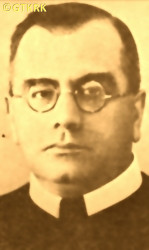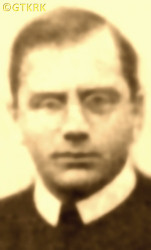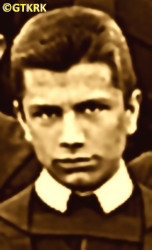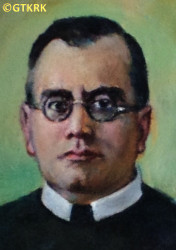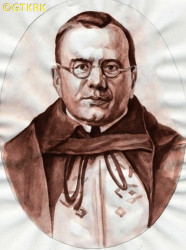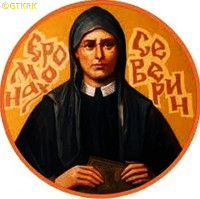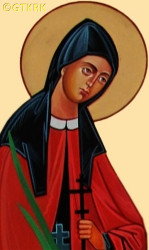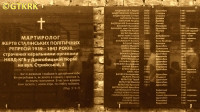Roman Catholic
St Sigismund parish
05-507 Słomczyn
85 Wiślana Str.
Konstancin deanery
Warsaw archdiocese, Poland
full list:
displayClick to display full list

searchClick to search full list by categories
wyświetlKliknij by wyświetlić pełną listę po polsku

szukajKliknij by przeszukać listę wg kategorii po polsku

Martyrology of the clergy — Poland
XX century (1914 – 1989)
personal data
religious status
blessed
surname
BARANYK
forename(s)
Steven (pl. Stefan)
religious forename(s)
Severin (pl. Seweryn)
beatification date
27.06.2001more on
www.swzygmunt.knc.pl
[access: 2013.05.19]

the RC Pope John Paul IImore on
en.wikipedia.org
[access: 2014.09.21]
function
religious cleric
creed
Ukrainian Greek Catholic GCmore on
en.wikipedia.org
[access: 2013.05.19]
congregation
Basilian Order of Saint Josaphat OSBMmore on
en.wikipedia.org
[access: 2014.09.21]
(i.e. Basilians)
diocese / province
Holiest Redeemer province OSBM (Galicia)
Przemyśl GC eparchymore on
pl.wikipedia.org
[access: 2013.05.19]
nationality
Ukrainian
date and place
of death
26.06.1941

Drohobychtoday: Drohobych urban hrom., Drohobych rai., Lviv obl., Ukraine
more on
en.wikipedia.org
[access: 2021.10.09]
details of death
At the beginning of World War I, in the face of the Russian attack on the Austro–Hungarian province and crown land of Germ. Königreich Galizien und Lodomerien (Eng. Kingdom of Galicia and Lodomeria), i.e. Galicia, the Theological School in Krekhiv, where had been preparing for the priesthood, was evacuated deep into the Austro–Hungarian Empire, to Zagreb. There completed studies and was ordained.
After the Russian defeat in the Battle of Gorlice in 05.1915, returned to his native diocese.
During the Polish–Ukrainian War of 1918‐1919, which was lost by the Ukrainians, Zhovkva, where ministered, from 01.11.1918 was occupied by Ukrainian troops. At that time, de facto served as the chaplain of the Galician Army HA units and of the field hospital. On 16.05.1919, Zhovkva was recaptured by the Polish troops during the decisive May offensive under the command of General Joseph Haller, which led to the Ukrainian troops being pushed out of Galicia. On 19.05.1919, interned — together with 41 other monks of the Basilian Fathers OSBM. Initially transported to the Brygidki prison in Lviv, and from there to the POWs and Internees Camp No. 1, in the Kraków district of Dąbie. Released on 04.08.1919.
After German and Russian invasion of Poland in 09.1939 and start of the World War II, after German attack on 22.06.1941 of their erstwhile ally, Russians, arrested on 26.06.1941 by panicking Russians — together with provincial superior, Fr Joachim Sieńkiwski.
Few days later, after Russian withdrawal and start of German occupation, bodies of both priests were discovered among c. 800‐1,200 corpses of people murdered by the Russians in interrogation jail in Drohobych — most of them were gunned down on the prison yard.
Before death was tortured — a cross was cut by a sharp instrument on his chest.
4 prisoners only survived the massacre.
cause of death
mass murder
perpetrators
Russians
sites and events
Prison massacres — Drohobych 06.1941Click to display the description, 06.1941 massacres (NKVD)Click to display the description, Drohobych (prisons)Click to display the description, Ribbentrop‐MolotovClick to display the description, Pius XI's encyclicalsClick to display the description, OJiI No. 1 DąbieClick to display the description, Polish‐Ukrainian war of 1918‐1919Click to display the description
date and place
of birth
18.07.1889

Uhnivtoday: Belz urban hrom., Sheptytskyi rai., Lviv obl., Ukraine
more on
en.wikipedia.org
[access: 2020.11.24]
parents
BARANYK Nicholas
🞲 ?, ? — 🕆 ?, ?

Anne
🞲 ?, ? — 🕆 ?, ?
religious vows
16.05.1907 (temporary)
21.09.1910 (permanent)
presbyter (holy orders)
ordination
14.02.1915

Zagrebtoday: Zagreb cou., Croatia
more on
en.wikipedia.org
[access: 2024.03.19]
positions held
1932 – 1941
hegumen–superior and parish preist — Drohobychtoday: Drohobych urban hrom., Drohobych rai., Lviv obl., Ukraine
more on
en.wikipedia.org
[access: 2021.10.09] ⋄ Basilians OSBM ⋄ Holy Trinity GC monastery ⋄ Holy Trinity GC parish ⋄ Drohobychtoday: Drohobych urban hrom., Drohobych rai., Lviv obl., Ukraine
more on
en.wikipedia.org
[access: 2021.10.09] GC deanery
1916 – 1932
monk and vicar — Zhovkvatoday: Zhovkva urban hrom., Lviv rai., Lviv obl., Ukraine
more on
en.wikipedia.org
[access: 2020.11.22] ⋄ Basilians OSBM ⋄ Nativity of Christ GC monastery ⋄ Nativity of the Blessed Virgin Mary GC parish ⋄ Zhovkvatoday: Zhovkva urban hrom., Lviv rai., Lviv obl., Ukraine
more on
en.wikipedia.org
[access: 2020.11.22] GC deanery — retreatist, preacher, catechist of several elementary schools, rector of an orphanage, editor of a magazine for children „Наш приятель” (Eng. „Our friend”)
1914 – c. 1915
student — Zagrebtoday: Zagreb cou., Croatia
more on
en.wikipedia.org
[access: 2024.03.19] ⋄ Theological Study (tempory location), Basilians OSBM — last year of theological studies (transferred due to the outbreak of World War I)
1907 – 1914
student — Krekhivtoday: Zhovkva urban hrom., Lviv rai., Lviv obl., Ukraine
more on
en.wikipedia.org
[access: 2022.08.06] ⋄ GC Theological School, St Nicholas GC monastery, Basilians OSBM — initially completing his education at gymnasium level
24.09.1904 – 1907
novitiate — Krekhivtoday: Zhovkva urban hrom., Lviv rai., Lviv obl., Ukraine
more on
en.wikipedia.org
[access: 2022.08.06] ⋄ St Nicholas GC monastery, Basilians OSBM
1904
accession — Basilians OSBM
others related
in death
DANIŁKOWClick to display biography John, GOSZKAClick to display biography George, HENTYSZClick to display biography Michael, MAKARClick to display biography Stephen, SIEŃKIWSKIClick to display biography John (Fr Joachim), KILARClick to display biography Joseph, BAJRAKClick to display biography Vladimir (Fr Vitalis)
sites and events
descriptions
Prison massacres — Drohobych 06.1941: After German attack of Russians on 22.06.1941 Russians murdered prisoners held in Drohobych Stryjska Str. investigative jail. The exact number of victims remains unknown — after German attack Russians brought many prisoners (c. 300) from nearby villages and did not even manage to register them. In the last days of 06.1941 Russian genocidal NKVD forced the prisoners onto the prison yard informing the inmates of impending release. When all congregated there from the guard towers they were slaughter by machine guns fire. Under stack of bodies four people survived. Altogether Russians together with a number of Jews eagerly helping them murdered then c. 1,200 people (though some might have been murdered earlier). (more on: pl.wikipedia.orgClick to attempt to display webpage
[access: 2017.03.24])
06.1941 massacres (NKVD): After German attack of Russian‐occupied Polish territory and following that of Russia itself, before a panic escape, Russians murdered — in accordance with the genocidal order issued on 24.06.1941 by the Russian interior minister Lawrence Beria to murder all prisoners (formally „sentenced” for „counter‐revolutionary activities”, „anti‐Russian acts”, sabotage and diversion, and political prisoners „in custody”), held in NKVD‐run prisons in Russian occupied Poland, Lithuania, Latvia and Estonia — c. 40,000‐50,000 prisoners. In addition Russians murdered many thousands of victims arrested after German attack regarding them as „enemies of people” — those victims were not even entered into prisons’ registers. Most of them were murdered in massacres in the prisons themselves, the others during so‐called „death marches” when the prisoners were driven out east. After Russians departure and start of German occupation a number of spontaneous pogroms of Jews took place. Many Jews collaborated with Russians and were regarded as co‐responsible for prison massacres. (more on: en.wikipedia.orgClick to attempt to display webpage
[access: 2021.12.19])
Drohobych (prisons): Before the outbreak of the World War II in 09.1939 a criminal prison functioned at Drohobych Truskawiecka Str. where c. 1,200‐1,500 inmates were held. After the start in 09.1939 of the first Russian occupation a new jail run by Russian NKVD genocidal organization was opened at Striyska Str. (by regional NKVD headquarters). There in 06.1941, after German attack of their erstwhile ally, Russians, NKVD perpetrated a genocidal massacre of prisoners. After German defeat and start in 1944 of another Russian occupation NKVD returned to the same buildings and again opened their jail, where hundreds and thousands of people suspected of not supporting Russia were held and interrogated. The jail was closed in 1959. The prison at Truskawiecka Str. however remained open throughout the World War II, both during Russian and German occupations, stayed open after the end of military hostilities and operates till today. (more on: btx.home.plClick to attempt to display webpage
[access: 2020.04.04])
Ribbentrop‐Molotov: Genocidal Russian‐German alliance pact between Russian leader Joseph Stalin and German leader Adolf Hitler signed on 23.08.1939 in Moscow by respective foreign ministers, Mr. Vyacheslav Molotov for Russia and Joachim von Ribbentrop for Germany. The pact sanctioned and was the direct cause of joint Russian and German invasion of Poland and the outbreak of the World War II in 09.1939. In a political sense, the pact was an attempt to restore the status quo ante before 1914, with one exception, namely the „commercial” exchange of the so‐called „Kingdom of Poland”, which in 1914 was part of the Russian Empire, fore Eastern Galicia (today's western Ukraine), in 1914 belonging to the Austro‐Hungarian Empire. Galicia, including Lviv, was to be taken over by the Russians, the „Kingdom of Poland” — under the name of the General Governorate — Germany. The resultant „war was one of the greatest calamities and dramas of humanity in history, for two atheistic and anti‐Christian ideologies — national and international socialism — rejected God and His fifth Decalogue commandment: Thou shall not kill!” (Abp Stanislav Gądecki, 01.09.2019). The decisions taken — backed up by the betrayal of the formal allies of Poland, France and Germany, which on 12.09.1939, at a joint conference in Abbeville, decided not to provide aid to attacked Poland and not to take military action against Germany (a clear breach of treaty obligations with Poland) — were on 28.09.1939 slightly altered and made more precise when a treaty on „German‐Russian boundaries and friendship” was agreed by the same murderous signatories. One of its findings was establishment of spheres of influence in Central and Eastern Europe and in consequence IV partition of Poland. In one of its secret annexes agreed, that: „the Signatories will not tolerate on its respective territories any Polish propaganda that affects the territory of the other Side. On their respective territories they will suppress all such propaganda and inform each other of the measures taken to accomplish it”. The agreements resulted in a series of meeting between two genocidal organization representing both sides — German Gestapo and Russian NKVD when coordination of efforts to exterminate Polish intelligentsia and Polish leading classes (in Germany called «Intelligenzaktion», in Russia took the form of Katyń massacres) where discussed. Resulted in deaths of hundreds of thousands of Polish intelligentsia, including thousands of priests presented here, and tens of millions of ordinary people,. The results of this Russian‐German pact lasted till 1989 and are still in evidence even today. (more on: en.wikipedia.orgClick to attempt to display webpage
[access: 2015.09.30])
Pius XI's encyclicals: Facing the creation of two totalitarian systems in Europe, which seemed to compete with each other, though there were more similarities than contradictions between them, Pope Pius XI issued in 03.1937 (within 5 days) two encyclicals. In the „Mit brennender Sorge” (Eng. „With Burning Concern”) published on 14.03.1938, condemned the national socialism prevailing in Germany. The Pope wrote: „Whoever, following the old Germanic‐pre‐Christian beliefs, puts various impersonal fate in the place of a personal God, denies the wisdom of God and Providence […], whoever exalts earthly values: race or nation, or state, or state system, representatives of state power or other fundamental values of human society, […] and makes them the highest standard of all values, including religious ones, and idolizes them, this one […] is far from true faith in God and from a worldview corresponding to such faith”. On 19.03.1937, published „Divini Redemptoris” (Eng. „Divine Redeemer”), in which criticized Russian communism, dialectical materialism and the class struggle theory. The Pope wrote: „Communism deprives man of freedom, and therefore the spiritual basis of all life norms. It deprives the human person of all his dignity and any moral support with which he could resist the onslaught of blind passions […] This is the new gospel that Bolshevik and godless communism preaches as a message of salvation and redemption of humanity”… Pius XI demanded that the established human law be subjected to the natural law of God , recommended the implementation of the ideal of a Christian state and society, and called on Catholics to resist. Two years later, National Socialist Germany and Communist Russia came together and started World War II. (more on: www.vatican.vaClick to attempt to display webpage
[access: 2023.05.28], www.vatican.vaClick to attempt to display webpage
[access: 2023.05.28])
OJiI No. 1 Dąbie: POWs and Internees Camp No. 1, in the Kraków district of Dąbie — one of the internment camps, during the Polish–Ukrainian war of 1918‐1919, the Polish–Czech conflict of 1919 and the Polish–Russian war of 1919‐1921 — for prisoners captured by the Polish Army, i.e. Ukrainians, Czechs, Russians. Established in 11.1918 on the site of a POW camp of the former Austro–Hungarian Empire. At its peak, in 03.1920, the camp held 4,987 people. Epidemics of typhus and dysentery broke out in the camp several times: e.g. in 12.1918, 02.1919. During the three years of the camp's existence, 1,104 people died there. Liquidated on 06.12.1921. (more on: dabiehistoria.blogspot.comClick to attempt to display webpage
[access: 2025.03.07])
Polish‐Ukrainian war of 1918‐1919: One of the wars for borders of the newly reborn Poland. At the end of 1918 on the former Austro‐Hungarian empire’s territory, based on the Ukrainian military units of the former Austro‐Hungarian army, Ukrainians waged war against Poland. In particular attempted to create foundation of an independent state and attacked Lviv. Thanks to heroic stance of Lviv inhabitants, in particular young generation of Poles — called since then Lviv eaglets — the city was recaptured by Poles and for a number of months successfully defended against furious Ukrainian attacks. In 1919 Poland — its newly created army — pushed Ukrainian forces far to the east and south, regaining control over its territory. (more on: en.wikipedia.orgClick to attempt to display webpage
[access: 2017.05.20])
sources
personal:
www.swzygmunt.knc.plClick to attempt to display webpage
[access: 2013.05.19], pl.wikipedia.orgClick to attempt to display webpage
[access: 2013.05.19]
original images:
pl.wikipedia.orgClick to attempt to display webpage
[access: 2019.10.13], catholicencyclopedia.in.uaClick to attempt to display webpage
[access: 2019.10.13], www.dobromyl-monastery.comClick to attempt to display webpage
[access: 2019.10.13], missiopc.blogspot.comClick to attempt to display webpage
[access: 2019.10.13], osbm.in.uaClick to attempt to display webpage
[access: 2019.10.13], cyclowiki.orgClick to attempt to display webpage
[access: 2019.10.13], www.grkatpo.skClick to attempt to display webpage
[access: 2019.10.13]
LETTER to CUSTODIAN/ADMINISTRATOR
If you have an Email client on your communicator/computer — such as Mozilla Thunderbird, Windows Mail or Microsoft Outlook, described at WikipediaPatrz:
en.wikipedia.org, among others — try the link below, please:
LETTER to CUSTODIAN/ADMINISTRATORClick and try to call your own Email client
If however you do not run such a client or the above link is not active please send an email to the Custodian/Administrator using your account — in your customary email/correspondence engine — at the following address:

giving the following as the subject:
MARTYROLOGY: BARANYK Steven
To return to the biography press below:
 Click to return to biography
Click to return to biography








